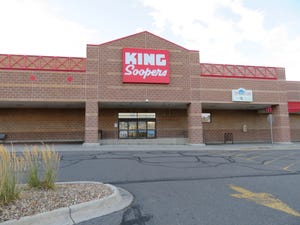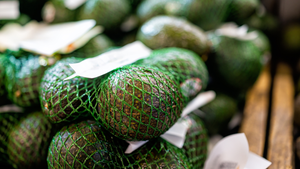BERRIED TREASUREBERRIED TREASURE
Summer berries are taking the lead in the battle for more space in supermarket produce departments.Retailers contacted by SN said they've caught on to the tremendous profit potential offered by summer berries and, as a result, are experimenting with new ways to merchandise the category in order to reap even bigger rewards.According to industry leaders, berries rank well above the average produce items
June 20, 1994
TONY SPLEEN
Summer berries are taking the lead in the battle for more space in supermarket produce departments.
Retailers contacted by SN said they've caught on to the tremendous profit potential offered by summer berries and, as a result, are experimenting with new ways to merchandise the category in order to reap even bigger rewards.
According to industry leaders, berries rank well above the average produce items in gross sales, profitability and sales per square foot.
Of the top 10 summer items sold in produce departments, strawberries, for example, ranked No. 3, just behind bananas and lettuce, according to a 1990 study by the U.S. Marketing Service, Sonoma, Calif. The
leading product in the berry category, strawberries, used only 3.8% of allocated space, yet generated 6.5% of total produce sales, the study found. Sales per square foot were $104.
Despite the great profit potential, berry merchandising doesn't come without its unique set of challenges. Berries, for example, are among the most perishable products in the produce department, often resulting in high levels of shrink. Preharvested berries are also extremely sensitive to weather conditions. Even a small amount of rain in the growing region prior to harvest can significantly reduce the size and quality of a crop. And effective merchandising at store level usually requires more labor hours than other produce items.
But even with these challenges, retailers report more success stories than failures. And as they look for ways to reap the tremendous profit potential that summer berries offer, they are expanding display space and packaging options.
In the last 10 years, for example, Grand Union Co., Wayne, N.J., has tripled the amount of space it allocates for berry displays.
"Berries are an extremely important part of our business," said Tom Gallahan, vice president of produce and floral for the 252-store chain.
Grand Union merchandises strawberries, raspberries, blackberries and blueberries in their own section, which it calls the Berry Patch, which is generally 8 to 12 linear feet, depending on the store.
During the peak growing season -- April to June -- berries account for almost 7% of produce sales, compared with 3% the rest of the year, Gallahan said. With continued improvement in availability, he added, "sales are steadily picking up."
At Pay Less Supermarkets, Anderson, Ind., the amount of space devoted to berries is at an all-time high. During this year's peak season, the nine-unit independent will allocate 15 to 18 feet of display space to berries and even to 20 feet in its busiest stores, according to John Dockrey, produce merchandiser. That's up from about 6 feet the rest of the year.
Strawberries, the fifth-largest year-round sales producer at Pay Less, alone generate 15% of sales during the peak season, 7% for an annual average.
Berries have been taken off refrigerated cases this year at Dorothy Lane Market in Dayton, Ohio, and placed on their own custom-made portable tables.
According to Jose Manzano, produce director for the two-store independent, the new tables help get berries out in front of the consumer as well as provide "a little more space" for the highly profitable product.
The California tables are made of wood and their tops are slanted at a 60-degree angle, which "gives the appearance of a massive display," said Manzano. Because they are on wheels, the tables offer the flexibility of moving the displays throughout the department and using more unique and creative merchandising techniques to heighten the visibility of berries, he said.
Last month, for example, four tables measuring about 5 feet by 5 feet each were grouped together in one of the Dorothy Lane stores and were used to merchandise strawberries and cantaloupes. Because of the angle of the tabletops and their positioning in the department, the displays could be seen by customers from virtually every side of the store, Manzano said.
The produce executives contacted by SN said they are either maintaining the amount of allocated display space this year or increasing it. Not one said space has been reduced. But the ways in which they are filling the space varies by company: from bulk to prepackaged berries in clamshell containers to repacked baskets that are overwrapped at store level.
"We are offering the customer more of a variety of package sizes, especially half trays" of strawberries, said Gene Battaglia, vice president of produce operations at Scrivner Inc., the nation's third-largest wholesaler, which is based in Oklahoma City and operates 170 corporate stores. "Half-tray merchandising cuts down on labor and gives you a larger ring at the register. The displays are easily maintained especially during the peak shopping periods."
Strawberries account for as much as 10% of Scrivner's produce sales during the peak months of April, May and June, Battaglia said.
Dockrey of Pay Less has started offering large, name-brand packages of premium strawberries, such as a 2-pound pack in a clear plastic clamshell container. "They are doing an excellent job," he said. "Consumers are willing to pay a premium for good berries."
Grand Union's Gallahan also is selling larger packs this year: a 16-ounce, name-brand premium pack as well as a "good value," lower-priced competitive pack. He said the packs not only are appealing to his customers, but they also help reduce labor costs. "For obvious reasons, as far as labor goes, they are absolutely the right way to go," he said.
Like most retailers, Gallahan still handles strawberries the traditional way: flats containing 12-pint baskets repacked at store level (usually into 13 pints) and overwrapped with a plastic film. He said, however, that he is putting more emphasis this year on prepackaged strawberries in a 10.3-ounce clamshell container.
"I can see the day when these could replace pints," he said. "Why do you want to bring [strawberries] into stores in pints and put cellophane on top? These are easier to work with and about the same size."
A produce director from a large Northeast retail company who asked not to be identified said he's not convinced that the packaged berries will replace those in baskets repacked at store level.
"We just started using prepacked clamshell containers for the first time," he said. "It's too early to tell how they will do. There is a significant cost difference."
He said prepackaged berries cost about 30% more than berries in standard packs, which he displays together.
"Side by side, I think it will be hard for consumers to justify paying the higher price," he said.
What about the labor savings for retailers? "You're just transferring the cost back to the shipping end," he said. "We still have to pay."
Despite his success with the large packs of berries, Pay Less' Dockrey said prepackaged berries will not replace handpacked containers at his company.
"We have tried prepackaged berries in order to save on labor, but they haven't been that successful," he said. "We can fill the baskets up higher and turn the stems down. We have built a reputation on that."
At Dorothy Lane Market, most strawberries are sold in bulk. The only prepackaged items are raspberries, blackberries and blueberries.
"Almost 90% of our berries sales are in bulk strawberries," said Dorothy Lane's Manzano. "We sell between 24 and 30 flats on a normal day. We put them out in flats the way they come in and constantly rotate them. Each day we also sell about two dozen pints and quarts that we pack daily."
Big Y Foods, Springfield, Mass., is experimenting this year with bulk strawberries in an attempt to save on labor.
"This year we have a test store where we're taking a bulk approach to selling strawberries by the pound," said Russ MacLean, director of produce for Big Y, which operates 30 stores in Massachusetts and Connecticut. "But we're still packing out of flats as well at store level. Getting baskets prepared at store level is one of our biggest challenges. Trying to have enough staff to break down flats and get them out on display fast enough can be a real problem."
Despite the demands that berry merchandising can have on labor, several produce executives said they have steered away from merchandising strawberries in bulk, a method they said often compromises quality and increases shrink.
"Scrivner stays away from bulk merchandising," said Scrivner's Battaglia. "It is labor-intensive and there is too much shrink. Many times the quality of the berry is lost with the consumer handling such a delicate item."
A produce merchandiser from a retail company in the Southwest agreed. "We've tried bulk berries with limited success," said the merchandiser who asked not to be identified. "Even though it can cut down on labor, shrink seems to increase because oftentimes berries cannot hold up to all the handling. Especially when the growing areas have a lot of rain like this spring and the quality has already suffered. We're probably going to be doing more with packaged berries."
Regardless of the type of merchandising practiced, all retailers contacted by SN agreed that the biggest challenge they face in promoting berries is Mother Nature.
"Rain can be a major problem on the long-term quality of the fruit," said Big Y's MacLean.
Dorothy Lane's Manzano agreed. "In order to sell bulk, you need to have good quality."
About the Author
You May Also Like




